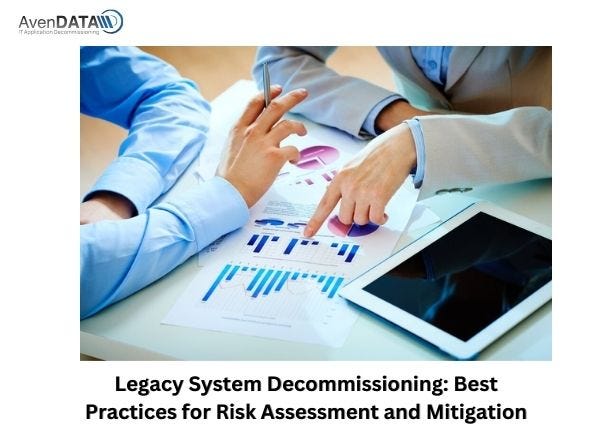Legacy System Decommissioning: Best Practices for Risk Assessment and Mitigation

In today’s rapidly evolving technological landscape, businesses are constantly faced with the challenge of managing legacy systems. These outdated systems not only hinder operational efficiency but also pose significant risks to data security, compliance, and overall business continuity. Legacy system decommissioning emerges as a strategic solution to overcome these challenges, offering organizations the opportunity to streamline operations, reduce costs, and improve agility. However, the process comes with its own set of risks and complexities that must be carefully managed.
Understanding Legacy System Decommissioning
Legacy system decommissioning refers to the process of retiring outdated IT systems, applications, or infrastructure components. It involves identifying redundant or obsolete technology assets, migrating essential data and functionalities to modern platforms, and safely disposing of or archiving legacy data. While decommissioning offers numerous benefits, including cost savings and improved performance, it also introduces inherent risks that could disrupt business operations if not addressed proactively.
Identifying Risks in Legacy System Decommissioning
Data Loss: One of the primary risks associated with legacy system decommissioning is the potential loss or corruption of critical data during the migration process. Without proper planning and data management strategies, organizations risk losing valuable information vital to their operations.
Compliance Violations: Failure to adhere to regulatory requirements during the decommissioning process can result in severe penalties, legal ramifications, and damage to the organization’s reputation. Compliance risks may arise from mishandling sensitive data, inadequate data retention policies, or improper disposal practices.
Operational Disruption: Legacy system decommissioning can disrupt day-to-day business operations if not executed smoothly. Interruptions in service, data accessibility issues, or compatibility issues with existing systems could lead to productivity losses and customer dissatisfaction.
Security Vulnerabilities: Outdated legacy systems are often more susceptible to security breaches and cyberattacks due to unpatched vulnerabilities and lack of modern security features. Decommissioning without adequately addressing security risks could expose sensitive information to unauthorized access or data breaches.
Resource Constraints: Limited budget, time, and expertise pose significant challenges in effectively managing legacy system decommissioning projects. Inadequate resources may result in project delays, cost overruns, and compromised outcomes.
Best Practices for Risk Assessment and Mitigation
Comprehensive Inventory and Assessment: Begin by conducting a thorough inventory of legacy systems, applications, and associated data. Assess the importance and relevance of each asset to determine the appropriate decommissioning strategy.
Data Mapping and Classification: Identify and classify data based on its sensitivity, regulatory requirements, and business value. Develop a data migration plan that prioritizes critical data and ensures its integrity throughout the decommissioning process.
Regulatory Compliance: Stay abreast of relevant regulations and compliance standards governing data privacy, security, and retention. Ensure that decommissioning activities align with legal requirements and industry best practices to mitigate compliance risks.
Data Backup and Preservation: Implement robust data backup and preservation mechanisms to safeguard against data loss or corruption during migration. Maintain multiple copies of critical data and verify its completeness and accuracy post-migration.
Security Measures: Prioritize cybersecurity throughout the decommissioning lifecycle by implementing encryption, access controls, and monitoring mechanisms. Conduct vulnerability assessments and penetration testing to identify and remediate security vulnerabilities proactively.
Change Management and Communication: Communicate transparently with stakeholders about the decommissioning process, potential risks, and mitigation strategies. Develop a comprehensive change management plan to minimize disruption and ensure smooth transition.
Vendor Due Diligence: If outsourcing decommissioning activities to third-party vendors, conduct thorough due diligence to assess their capabilities, experience, and security protocols. Establish clear contractual agreements and service-level agreements to hold vendors accountable for deliverables.
Testing and Validation: Conduct rigorous testing and validation of migrated data, applications, and systems to ensure functionality, compatibility, and performance. Establish rollback procedures and contingency plans to address unforeseen issues or failures.
Training and Skill Development: Invest in training and skill development programs to equip staff with the knowledge and expertise required to execute decommissioning tasks effectively. Empower employees to recognize and respond to potential risks in real-time.
Continuous Monitoring and Evaluation: Implement ongoing monitoring and evaluation processes to track decommissioning progress, identify emerging risks, and make necessary adjustments. Foster a culture of continuous improvement to enhance decommissioning practices over time.
Conclusion
Legacy system decommissioning presents significant opportunities for organizations to modernize their IT environments, improve operational efficiency, and reduce overhead costs. However, it also entails inherent risks that must be addressed through diligent risk assessment and mitigation strategies. By following best practices and adopting a proactive approach to risk management, organizations can navigate the complexities of legacy system decommissioning with confidence, ensuring a smooth transition to a more agile and resilient IT infrastructure.
